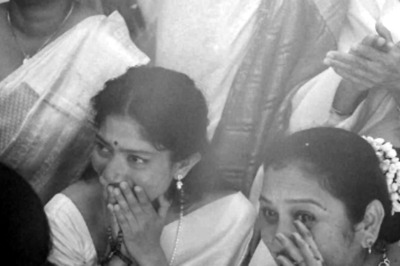
views
The National Defence Academy (NDA) is modifying its infrastructure with the creation of separate enclosures, cabins, additional washrooms and also putting in place a robust security apparatus to welcome women cadets from mid-2022, Major General Arvind Bhatia (retd) told News18.com.
Major General Bhatia, who superannuated last month as an Assistant Chief of Integrated Defence Staff (ACIDS) at Headquarters Integrated Defence Staff (HQ-IDS) had been looking after the functioning of all tri-service training institutions, their administration, curriculum and other policy interventions.
In an interview to News18.com, the Army veteran said that it was known to the defence establishment that the NDA would soon admit women cadets—since the time Sainik schools started admitting girl children a few years back.
“As a natural progression, those girl students graduating from the Sainik schools would have wanted to join the NDA. So, we had already started preparing,” he said.
In September this year, the Supreme Court had ruled that women be inducted into NDA from this year itself, and not from next year as sought by the Centre.
Detailing the requisite changes to be made in the NDA for women cadets, he said that initially a portion of an existing squadron—which houses around 110 cadets—would be segregated and associated infrastructure would be created for the first batch.
A different set of women instructors, doctors including gynaecologists, and other requisite support staff would also have to be appointed for the women cadets when they join next year, he added.
Major General Bhatia, who has been an Instructor Class C and later Adjutant at the IMA, said a separate panel is already working out other modalities regarding the induction of women cadets in the NDA in consultation with the three service headquarters—including assessing what should be their physical fitness and medical parameters such as height, weight, eyesight, and how different they could be from the women officer trainees who join the Officer Training Academy (OTA), Chennai.
“The parameters may require slight tweaking, since women officer trainees at OTA join after graduation, whereas the girl cadets joining the NDA would be joining after their class 12 board exams at 16-17 years of age,” he said.
Major General Bhatia said the idea would generally be to progressively have around 120-150 women cadets in the NDA in all the six terms combined at any given time.
At least 70 per cent of the officer cadets from the NDA join the combat arms in the services—this includes the Infantry, Armoured and Artillery in the Army, which are still not open for women in the defence forces.
Clarifying that the strength of male officers getting into the defence services may not be reduced, he said that the overall cadre management, however, will have to be worked out by the three services.
“It has been a work in progress and it has to be seen if there has to be any corresponding reduction from the OTA Chennai intake to cater to the intake of women cadets in the NDA,” he said, adding that this will depend on the percentage of women the services are planning to induct.
The exact physical fitness standards for the women cadets are unlikely to see much dilution compared to the existing parameters for male cadets as many of them may eventually be deployed in difficult operational areas, which requires high levels of physical fitness parameters.
He said there are nearly eight months to go for the first batch of women to the NDA and recommendations to this effect, after due analysis, will be approved by the Chiefs of Staff Committee and then a final decision on all these aspects will be taken.
‘More joint training in the works’
Talking about the necessity to have more integration in military training of the three services, Major General Bhatia said any modern armed force has to operate jointly and that is possible only if the defence forces train together.
“If we don’t synergise and train together, we will not be able to operate during wars together,” he said, adding that it is being examined how to further enhance jointness among the three services and make it a continuous process, not only for the officers, but also for the men.
The Army veteran said a study was also ordered to examine ways to enhance integration in the training of the defence forces, the recommendations of which are being analysed by the HQ-IDS.
News18.com had first reported that a common doctrine for training the armed forces and jointly training Junior Commissioned Officers (JCO) and other ranks in the tri-services were among the recommendations of the study.
Major General Bhatia said there are already a few Joint Training Services Institutes (JSTIs), which are currently operational in the fields of intelligence, law, music, catering.
“Plans to combine resources of fields like physical training and provost were also under active consideration. This was to avoid duplication and optimise manpower and other resources involved in training and administration of the institutions, which were working individually in these fields earlier,” he said.
He also said that he is hopeful the Indian Defence University (IDU), which is yet to see the light of day, will soon get the Parliament nod.
He said that the need for such a university was espoused nearly 40 years ago. “Given that all developed militaries have a national defence university, India needs to have its own academic institution as well on priority, which other military institutions could be affiliated to,” he said.
Stating that the university will encompass subjects related to national security, including operational art, strategy, cutting-edge technology, defence management and research work, he said, “Everything is in place and we are hopeful in the near future we would get the go-ahead from Parliament to have it up and running.”
‘Training didn’t suffer because of Covid’
Major General Bhatia said that the Covid pandemic has changed the way the defence forces thought and trained and some basic tweaks made it possible.
“One major positive is that Covid-19 hastened the usage of information technology by the armed forces, which were traditionally wary of it,” he said.
This, he explained, happened through videoconferences, virtual guest lectures, webinars, online classes, and also by adopting a hybrid model in which additional reading material would be sent to officers before they would attend the lectures.
He added that there were also staggered timings for training activities and meals to prevent crowding and some other activities and sports like swimming were replaced with other activities at the training institutions.
He said for the first time, parents and guests were restricted from attending events like passing out parade as a Covid-19 precaution.
“In the NDA for instance, 300 support staff stayed inside the academy to keep the campus sealed from any virus transmission from outside during the peak pandemic period last year,” he said.
“There were also longer breaks for cadets in winters and no summer breaks, so that they would be quarantined just once and to ensure the training did not suffer,” he said.
“These tweaks ensured that training, despite delayed induction of newly selected cadets was never adversely impacted. “The pandemic couldn’t have been an excuse to not train as national security is an inviolable imperative,” he said.
Read all the Latest News , Breaking News and IPL 2022 Live Updates here.




















Comments
0 comment